
Can Old Concrete Be Stained?
The most prevalent question we are questioned relating to old concrete is that of staining of them. Concrete patios and walkways are attractive to be looked at but with the passage of time become outdated.
The answer to whether old concrete can be stained is yes. They can be acid stained. The process for doing so is not quite difficult to be done, just a few appropriate pieces of information are to be known, along with some extra steps to be taken.
Acid stains are nothing but coloured washes, which are to be soaked into the pores present in concrete. Unlike paints, stains are not surface covering in nature.
If the stain is not getting soaked into the pores of the concrete, then it will not be able to cover as required. This in turn indicates that old concrete will not be able to get sealed, or painted when it is to be stained or to be coated with epoxy.
The age of concrete does not relate to the stain’s effectiveness while the condition of concrete is the determining factor. We should remain away from paint and acrylics as both are masked as paints. They act as surface covering but not as our required stains.
By applying the above materials, they will not be absorbed into the old concrete in the required time. Therefore with the passage of time, they will get husked up and will look disgusting.
Again, restoring them will cost you money in the long run. The stain which will be real in nature, forms a chemical reaction, that will permanently change the concrete’s colour.
While staining old concrete, at any cost, it is to be made sure that the surface should be properly cleaned, and free from any kind of stains, old paints and true acid stains should be used.
Also Read: Difference Between Rafter and Truss
Concrete Stain Is Permanent
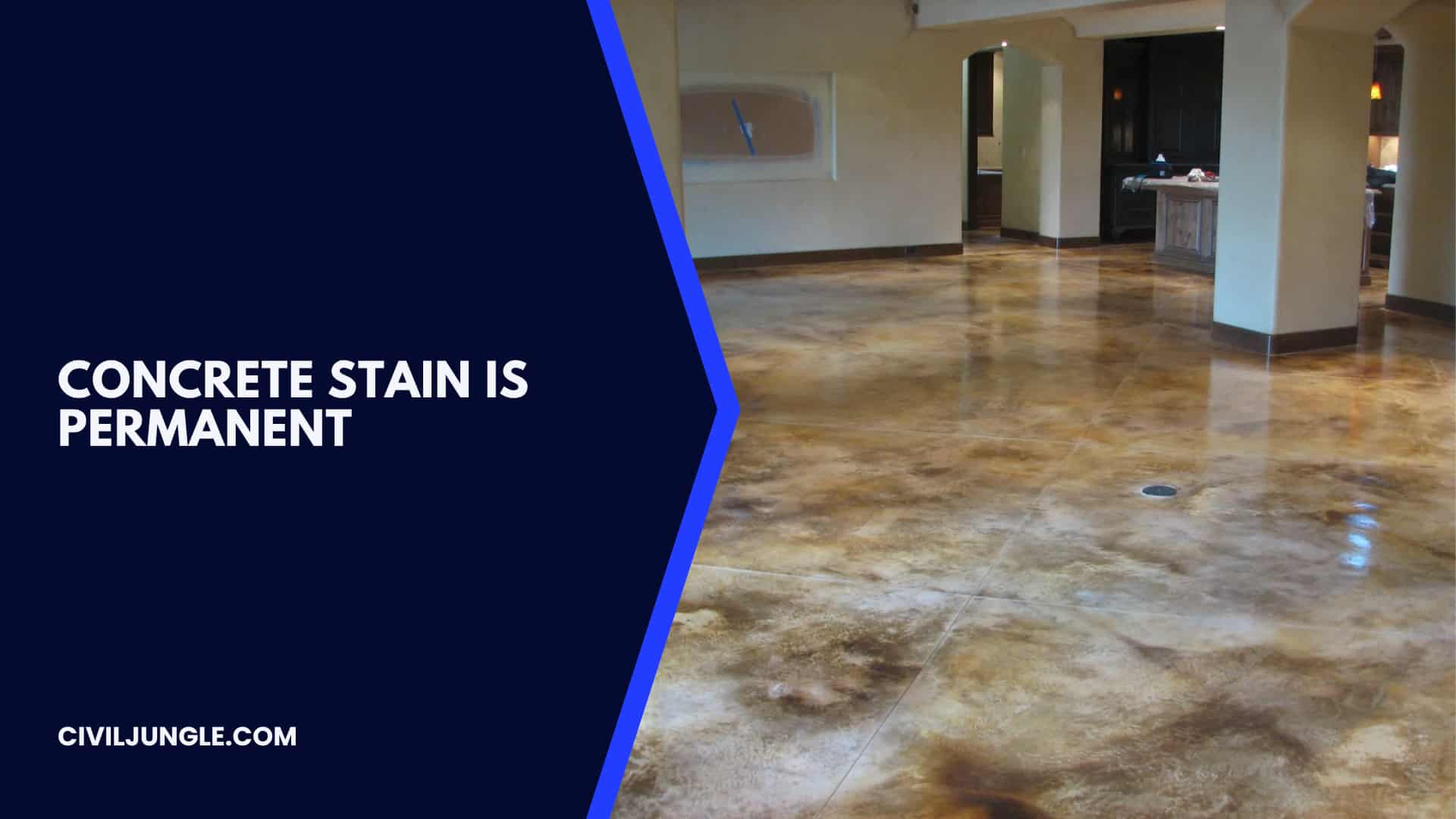
It is to be kept in mind that once the old concrete surface is stained, the color will be permanent. The stain will penetrate and be absorbed into the pores of concrete. There will be no way left to remove the stain once applied.
Unlike paint or acrylic stain will not be a surface leveler. Color sampling should be done on concrete, before stain is to be applied, especially while working in indoor conditions. Acid stains might sometimes be impossible to be removed and can be tough in nature.
Can Your Old Concrete Be Stained?

It is a fun and convenient way to freshen up old concrete surfaces by staining old concrete surfaces. Just while staining the concrete must be clean and made free from any kind of debris. The quality of staining depends on the condition of the concrete.
At times new concrete can not be stained also if the surface is grimy, dirty, and covered with paint or sealant. For staining your concrete, it must be clean and bare surface.
It is so, due to the working characteristic of acid stain. Acid concrete stains are a thin mixture consisting of chemicals and color. As soon as it is poured on the surface of old concrete, it gets absorbed into the pores of concrete and colour is created.
Due to the above process if dirt will be present, the pores will be filled which in turn will obstruct acid stains to be soaked into pores. Any sort of material can lead to the filling of pores, but the most prominent among them are sealers, dirt, paint, and grime.
Paint, sealant coats, and epoxy seep into the pores and blocks them. So, in that case, the oldness of concrete will not be a factor for effective staining blockage will be the obstructing factor for getting the proper results.
The best thing is regardless of the concrete’s age surface can be properly stained regardless of the fact the surface is properly cleaned.
If a condition arises that an older concrete surface has got paint on it or is sealed there is nothing to worry about. Few ways are available to get them removed.
Just muriatic acid should not be applied for cleaning paint as it will lead to the destruction of important required minerals which are essential for the production of the colour range which we want from concrete stain.
Removing Paint
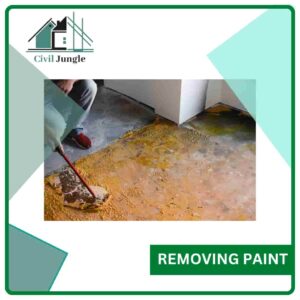
Industrial paint remover is the best way for removing paint from the required concrete surface. It is to be laid on the surface and then waited for it to work. Paint removers result in lifting off the paint on concrete.
Once it is seen that the paint softens and starts to lift from the concrete surface, a hand scraper or power washer is to be taken and remove as much paint can be removed.
Everything can not be removed in one go, so repeated action should be done as required for proper completion. After the removal of the total paint, the surface should be cleaned and dried properly.
Removing Sealant

For protecting concrete from water damage, the sealant is to be used. It is generally recommended for any concrete patio surface. This sealant prevents the proper application of stain, as the sealant will penetrate the pores and result in blockage.
A seal and stain can be used together, following one rule, i.e., the stain should be applied first. After that sealant is to be applied.
Removal of paint is much easier than sealant to be removed. With the passage of time sealer fades away, for this reason, reseal of concrete is mandatory. If someone does not need to wait for the fading away of the sealant, a pressure washer should be used for washing away the sealant.
For the removal of tough sealant, you can try Xylene. The material is poured on concrete, then let it settle for about 30 seconds, and then it is to use a stiff brush to scrub it off. At last use a scraper for removing the sealer. Repeat if required.
Removing Wax
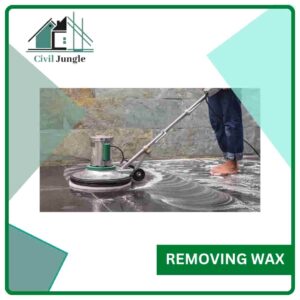
If wax has built up on the surface of the concrete, a floor wax remover is required. The floor wax remover is to be applied on the old surface, then let it sit for a certain time, after that scrub off with a soft bristle brush. Until the floor wax is properly removed mop the affected area.
Removing Epoxy
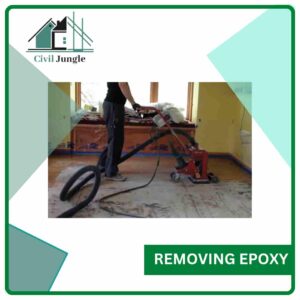
For finishing the concrete epoxy is used sometimes and staining will not be possible. So, the epoxy finish must be removed prior to the application of staining. The most hard-to-remove material is epoxy as compared to sealer and paint.
The most effective ways to remove epoxy from concrete are:
- Acetone: The concrete is to be soaked in acetone and then you need to wait to get them soft so that they can be scrapped off.
- Heat Gun: Evaporate and peel off the epoxy from the concrete surface, at a single time small sections are done part by part
- Paint Thinner: The same method should be used as used with acetone.
- Sanding: This option is an extreme category, but the top layer of concrete can be covered with sand. Doing so, will help in the removal of traces of acrylic and in turn a smooth surface will be created for staining.
A combined material of the above three methods can also be used. The concrete is to be soaked in either acetone or paint thinner and scraped when ready. A heat gun can be used for hardening the clean areas.
Also Read: How To Make A Window Seat More Comfortable
Acid Staining Old Concrete
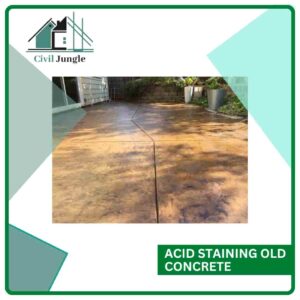
It is to be remembered that staining old concrete is not a big different from staining new concrete. It all depends on the condition of the concrete. As soon as it is clean and dried the surface can be stained.
Old concrete will have dirt, sealant, paint, mildew, or substances entrapped in the pores of the concrete. Cleaning is the most essential step which should not be skipped.
Just after cleaning the major issues which will affect the effectiveness of stain like, old sealant, paint, or acrylic is removed, the concrete is to be cleaned by mopping, sweeping, and scrubbing them with the help of concrete wash or just simple soap with hot water.
If by any chance dirt, dust, pollen or other substances are left on the concrete after staining is done they can be noticed.
Test for Old Sealants

It is to be made sure that bare and clean concrete is stained, a test is to be conducted to make that sure. The best way to test so is by pouring little water over the entire required surface. As soon as you see the water gets soaked, staining can be started.
Whereas if water gets puffed on the surface or gets blocked on the surface, then further cleaning is required. Acrylic and paints are easy to get spotted. Anywhere on the concrete surface can be cleaned off that is not bare concrete.
A test like the above mentioned can be performed in the last step, since if some extra sealant gets remained on the surface, then that also can be cleaned before staining.
Otherwise, if that is not done the areas will not hold stains then the concrete will be looking blotchy.
Colour Test the Concrete
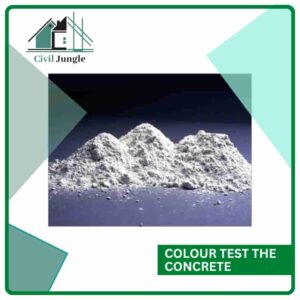
Stains might get a different look when applied on actual concrete, rather than on a test swab or picture. Stains undergo a reaction when applied to the concrete.
It is not the same as applying paints where the color will be exactly the same as the sample. For this reason, some testing is to be done. On the small test area apply some stain, just before you stain the entire surface.
Then an area is to be picked that will not be noticed. Then stain a very minimal spot then see what the colour will look like when dried. If the colour is not liked by you, adjustment can be done as required and then again tested.
Can Old Concrete Be Stained?
Your existing old concrete should be fine to stain, so long as it is not contaminated with glue, paint, oil, grease, sealers, waxes, or anything else that would prevent the stain from soaking into the pores of the concrete.
Staining Concrete Patio
- Step 1: Clean dust, dirt, and debris.
- Step 2: Repair cracks with concrete sealant.
- Step 3: Prepare the stain.
- Step 4: Apply stain with a sprayer, roller, or brush.
- Step 5: Let the stain dry.
- Step 6: Use a concrete sealant to protect the stained surface.
How to Stain Outdoor Concrete?
- Step 1: Sweep. Start by using a broom to sweep the concrete off, removing leaves and debris.
- Step 2: Scrub the Patio.
- Step 3: Pressure Wash.
- Step 4: Apply Concrete Cleaner.
- Step 5: Let it Dry.
- Step 6: Apply the Paint or Stain.
- Step 7: Add a Sealer.
Pros and Cons of Staining Concrete
- Pros: Very durable connection with, and penetration into, the concrete canvas.
- Cons: Requires ongoing maintenance through resealing.
- Pros: Very user-friendly.
- Cons: Not as durable in exterior applications as acid stain.
How Long Does Concrete Stain Take to Dry?
Allow the stain to cure for a full 24 hours, then spread the sealer along the floor as directed on the label. Drying time for the sealer can vary depending on environmental conditions. Plan on two days for it to completely harden. Consider using a concrete floor polish to help reduce slipping and scuffing.
Best Outdoor Concrete Stain
- VIVID Acid Stain. Regarded as one of the best acid-based stains both for indoor and outdoor use, the VIVID brand is highly regarded as a universally great choice. ..
- Kemiko Stone Tone.
- Concrete Resurrection.
- Surecrete Ecostain.
Is Staining Concrete a Good Idea?
Stains are a great way to add decorative effects to concrete both indoors and outdoors. Try to keep it simple by employing just one color in a certain hue that will complement your property’s visual aesthetic. Natural earthly tones are in high demand since they blend in very well with different structures.
Can You Stain Old Concrete Driveway?
Staining is an economical and highly versatile way to upgrade the look of both new and existing concrete driveways. Stains penetrate deeply into the concrete surface, producing fade-resistant, permanent color that will not flake off or peel away.
How Long Does Stain on Concrete Last?
Few materials have the longevity of concrete. And because stains permeate the concrete to infuse it with permanent color, a stained concrete floor or pavement should last a lifetime when properly maintained (see How to Protect and Maintain Stained Concrete .
Do You Have to Clean Concrete Before Staining?
To prepare the concrete floor for staining, you’ll need to first clean it of any dirt or debris. You can do this with a broom and dustpan, or with an industrial wet vacuum. This will remove dirt from the surface, as well as any grease or oil that may have been left behind.
How Often Do You Have to Restain Concrete?
Many experts agree that concrete flooring should be sealed every 2-5 years, in order to preserve and protect your floor.
Like this post? Share it with your friends!
Suggested Read –

